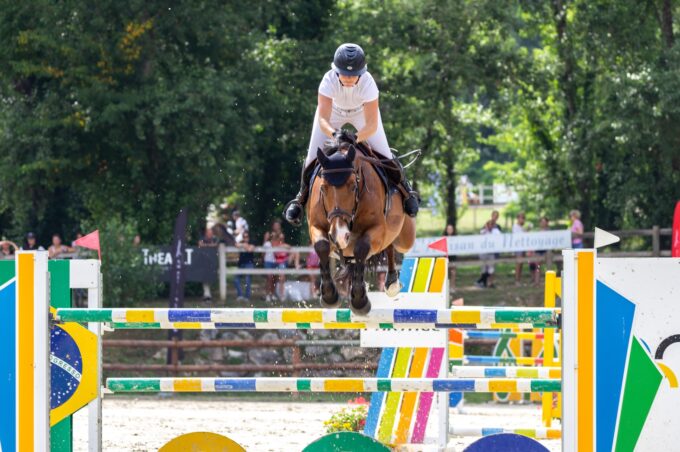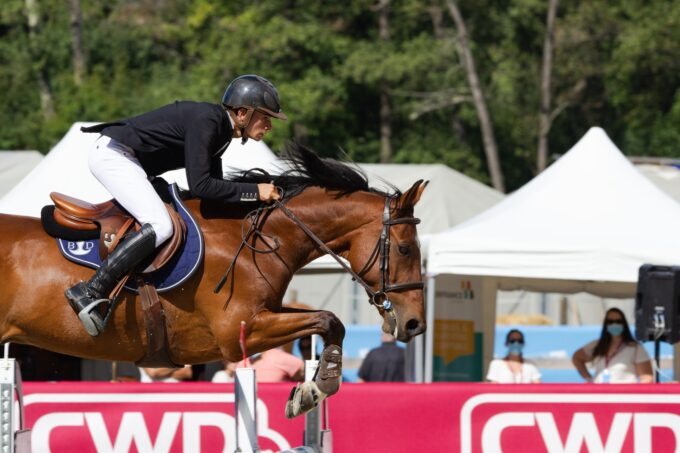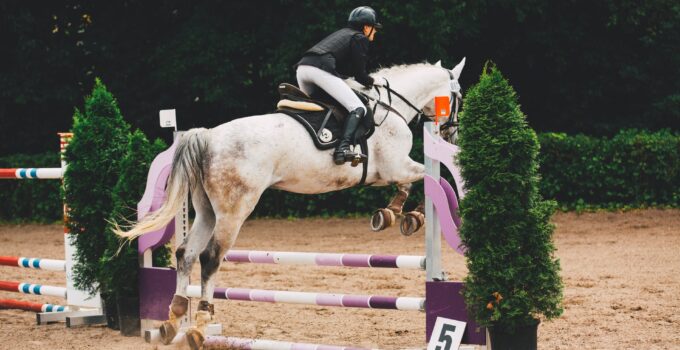Just owning a horse is both quite a responsibility and a lot of fun. We all know how social our 4 legged friends really are and how much trust and care they need.
Broadly viewed equestrianism is even more exciting and considered a natural progression to just having a horse. Dressage and trail riding are amusing leisure activities but no one would consider them an extreme sport.
This leaves all the horse riding enthusiast adrenaline junkies with just two options, because let’s face it – unless you’re really bad at handling and taking care of your horse you won’t be rodeoing it. Horse racing and horse jumping. This article will focus on the latter – we’ll talk about benefits of horse jumping, how to get into it and what to keep in mind while taking on fences with your horse.
For many people, who start horse riding, one of their primary goals is to quickly advance into horse jumping. We agree – there’s nothing quite as majestic as the sight of a rider jumping obstacles with their trusty steed.
But as exciting as horse jumping may be, you must remember that it’s also dangerous and should be practiced with care and patience. You’re going to fail and fall more than once and it’s not going to be pretty. You have to master the basics of riding before you proceed to the advanced techniques, especially horse jumping. you’re going to fall more than once and it’s not going to be pretty.
Horse jumping doesn’t just require a lot of patience, command, confidence, and focus, but it also requires having guts to fail over and over and a huge degree of trust established between the rider and the horse. The horse must trust you to lead it in the right direction and you must trust the horse to leap over the fence. It takes time and confidence to build that trust.
But the wait is entirely worth it — most riders state that there are few things in life more exhilarating than jumping past obstacles with their horse.
In this article, we discuss all the benefits of horse jumping and some valuable horse jumping tips for beginners.
Rewards of learning Horse Jumping
The benefits of horse jumping are way too diverse to list in their entirety. But they can be broadly grouped into two categories — Joy and Growth.
Joy

Source: unsplash.com
Horse jumping is nothing short of an extreme sport — and, like most extreme sports, it’s incredibly enjoyable, exciting, addicting and rewarding at the same time.
Horse jumping requires extreme focus, bodily control, balance, confidence, and established trust with the steed. If you’re not careful or prepared enough, it can even be extremely risky. But that’s all a part of the fun.
One of the primary reasons people engage in horse jumping is because of the jolt of adrenaline it sends through your body. You may have already heard of the term “adrenaline rush” in various other contexts.
Adrenaline is a chemical secreted from the adrenal glands during stressful, exciting, or dangerous situations. As such, an adrenaline rush generally occurs when you straddle (excuse the pun) the boundaries of danger and excitement.
Horse jumping is one of the most rewarding sports because it comes with its fair shot of adrenaline. And the sensation of leaping through the air astride your steed and successfully conquering the obstacle is unlike any other.
So if you want to experience one of the purest joys and pleasures of life, learn horse jumping!
Growth

Source: unsplash.com
Horse riding and jumping are widely considered to be developmental and therapeutic, both physically and emotionally.
The following are some of the primary ways in which horseback riding and horse jumping can promote your physical and mental health.
-
- Focus: Horseback riding requires a lot of focus and horse jumping quadruples the amount of focus and attention you need. You need to be completely attuned to your horse and focus on nothing other than the upcoming obstacle. If your mind wanders, your horse can sense it and wanders as well. As such, horse jumping helps you develop a keen sense of focus and attention, which is useful in every aspect of life.
- Strength: Horse jumping calls for both mental and physical strength and prowess. You need to be emotionally and mentally strong enough to tune into your horse’s emotional needs but you also need to have the physical strength to stand up and take command. As such, horse jumping is a great conditioning exercise for your body and mind.
- Patience: As mentioned previously, it takes a lot of time and practice before you can start horse jumping. You need to master the ability to sit back, breathe, and simply connect with your horse. That teaches you patience.
- Trust: When you’re horse jumping, you have to trust your safety and well-being on a 1,200-pound animal and they have to trust you in return. Establishing trust with a horse takes time and it can help you build trust with other people in your life as well.
- Bravery: Even if you’re somewhat of a scaredy-cat right now – you won’t be at the end of your horse jumping journey. Overcoming obstacles, both physical and emotional, changes and refines your character.
While these are some of the primary therapeutic benefits of horse jumping, they’re by no means comprehensive. Horse jumping also helps develop confidence, discipline, and it gives you an immense sense of accomplishment in life.
Horse Jumping Tips for Beginners
So now that you understand why you should start horse jumping, you should also take note of some tips for beginners. Horse jumping is a challenging exercise and you must practice caution and safety above all else.
Pick The Right Horse
Your ultimate goal – beating the show jumping ring requires leaping over a succession of fences in a timely manner. The horse must be strong mentally, with a huge degree of trust established with its rider. It also has to be strong physically as conquering the obstacles takes a lot of strength, stamina and the recovery between the jumps in the ring has to be immediate.
Always Learn Horse Jumping with an Instructor

Source: unsplash.com
You should never attempt horse jumping without an instructor. This is necessary for the following reasons:
- Horse jumping is dangerous if you don’t use the correct equipment and techniques.
- Not all horses are trained for executing jumps. Some of them get spooked when it comes to making a jump, which is dangerous for the rider. Your instructor can match you to the correct experienced horse.
- You will also need the right horse so they can make up for any minor mistakes you make — mistakes that may be extremely dangerous if you ride an inexperienced horse.
- A good instructor will help you learn the proper techniques and positions and take you through smaller jumps to build confidence before you can attempt larger jumps.
Always Use Secure and Reliable Equipment
We can’t stress it enough – Horse jumping is an extreme sport. If you’re rock climbing you don’t want to be using untested, worn ropes. Same goes for horse jumping – faulty tack can cause damage. Even more so a badly constructed fence is a hazard for both you and your horse’s health. We advise to only use horse jumps from established manufacturers with proven track records (e.g. GetJumps) using materials traditionally considered as premium, like aluminum and wood. Not only is training on quality jumps safer, but it also makes progress easier and quicker. Premium aluminum and wood horse jumps have some major advantages over their polyethylene counterparts. To name a few:
- Weight – A wooden pole weighs enough to be less forgiving for the horse. This leads to the horse respecting it more than the lighter poles and prevents developing bad practices.
- Durability – There’s no price tag on safety. The more durable the jump the safer it is.
- Training optimization – Aluminum horse jumps allow for milling keyhole track directly into the frame making height adjustments brief, which leads to better using your training time.
Other Valuable Horse Jumping Tips for Beginners

Source: unsplash.com
- Never look down while making a jump. Keep your gaze centered on the space between the ears of the horse because it will help with balancing.
- Make sure that the horse has reigns while still keeping a tight grip on the horse throughout the jump.
- Maintain a firm leg with all your weight passed down to the heels.
- Before you can teach your horse how to jump, you need to master confidence. Horses can sense nervousness and the slightest hesitation on your part will lead to skittishness.
- Before you start horse jumping, you must develop a secure seat at all gaits, be it a walk or a gallop. Maintaining a secure seat is crucial to ensuring your safety and comfort while horse jumping.







